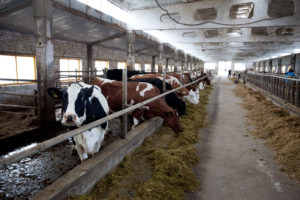Progress harvesting and animal husbandry. Prime Minister visits Gomel region

August 19, Rogachevsky district. Prime Minister of Belarus Roman Golovchenko is visiting the Gomel region on a working trip, the agenda includes issues of harvesting and the state of affairs in animal husbandry, BelTA informs.
The first point of the Prime Minister's route was the SUP "Zabolotye-2010" in the agricultural town of Zapolye. Here, Roman Golovchenko visited the field of the farm, got acquainted with the course of the harvesting campaign in the region and the district, visited a dairy farm for 600 heads, which was commissioned in 2019 and supplies an exclusively top-class product. In total, there are 767 livestock facilities and 194 farms in the region, which will decrease by the end of the year, taking into account the addition of small ones to larger ones - about 160.There are 17 farms on the territory of the Rogachev region, of which the SUP "Zabolotye-2010" is one of the largest. it is included in the raw material zone of the Rogachev Dairy Canning Plant and, accordingly, receives due support from the enterprise. Employees led by a young leader are focused on the result, which is achieved by production discipline and worthy stimulation of labor. The average salary is Br1.2 thousand, the number of employees is about 400 people.
In Zabolotye there are 6 dairy and 3 commercial farms, the number of dairy herds is 2.85 thousand heads. In total, almost 47 tons of MILK is produced here per day (102% of the level of the previous year), which is used to manufacture products of the Rogachev plant. Moreover, 80% of all milk is extra class and 20% is premium. Most of the production goes to the production of baby food. The farm also specializes in the production of beef and earns about Br300,000 a month from MEAT alone. The bulls are grown to a standard weight and delivered to the Zhlobin meat processing plant.
In "Zabolotye-2010" they are sure that the high quality of meat products can be achieved mainly with good feed. Farm workers prepare them themselves. For example, here any day they will start harvesting corn for silage. “There are no problems with the forage base, as of today, almost 18 thousand tons of haylage have been harvested - more than 100% compared to last year,” said Maksim Bekhtin, executive DIRECTOR of the Zabolotye-2010 SUE. “However, we do not stop and mow the third mowing, prepare the hay."
In the Rogachevsky district, the area harvested this year amounted to almost 31 thousand hectares - these are spring and winter grains, excluding buckwheat and millet. To date, more than 80% have been harvested, more than 52.2 thousand tons have been harvested. The average yield is 24 centners per hectare - 2.3 centners per hectare higher than last year. This year, the first laying of winter barley was made in the region - 842 hectares of this crop were sown. Local farmers received from this area a yield of 31 centners per hectare (individual farms - even 39 centners per hectare) - an above-average result. This year, the area under winter barley will increase by almost 70% - up to 3.5 thousand hectares.
The state order in the region has already been completed by 70%, including malting barley delivered by 93%. There are already 17 thousand-strong crews and 19 drivers who transported 1 thousand tons of grain from combines. Another 4 drivers became 2000ers in this harvesting campaign. To date, 3 farms have already completed the harvesting of grain, including the SUP "Zabolotye-2010" is completing it today. The gross grain harvest here is 9.5 thousand tons, the average yield on the farm is 30 centners per hectare (plus 2.8 centners per hectare compared to last year). The total area of farmland on the farm is 11,000 hectares, including 8,000 arable land.
If we talk about the Gomel region, this year the gross grain harvest is expected to be about 830 thousand tons against almost 790 thousand tons in 2021. To date, about 80% of the area has been harvested, the average yield was 24.2 q/ha. In a good scenario, the harvest will be completed within a week. The results of this year have shown that it is necessary to make changes in the structure of crops. For example, the sown area for winter barley will increase from 6.2 thousand hectares this year to 39 thousand hectares next. By the way, the crop yield was 35 c/ha (for comparison, spring barley - 21 c/ha). The total area of all winter crops will increase from 300 to 360 thousand hectares. In turn, crops of spring oats and barley will be reduced.
According to Ivan Krupko, chairman of the Gomel Oblast Executive Committee, one can work on the land and get good results. The main thing is that the technologies are observed and the weather does not let down. For the past 5 years, the region has been constantly facing dry weather. Undoubtedly, this affects both crop production and animal husbandry - there are losses in both milk and meat. It then takes a significant amount of time to stabilize the situation. Another important point for agriculture is experienced personnel who understand the strategy in crop production and the specifics of animal husbandry. In the region, they rely on young people in this matter, who are trained and supported in every possible way - both financially and through the provision of housing.
Photo by Oleg Foinitsky
Read together with it:
- О самых распространенных причинах пожаров рассказали в МЧС2 октября, Минск. О самых распространенных причинах пожаров рассказал начальник главного управления надзора и профилактики МЧС Дмитрий Турчин на "Предупреждение чрезвычайных ситуаций в осенне-зимний период. Профилактика пожаров и гибели людей от них", которая прошла в БЕЛТА. "В республике наблюдается рост количества пожаров на 7,7%, и на 1......
- В Раменском выведена новая порода кроликов — Великородская белаяЭто значимое событие обозначает первую отечественную породу, разработанную для племенного и промышленного производства за последние 60 лет. Глава Раменского муниципального округа Эдуард Малышев посетил институт, где директор, доктор биологических наук Глеб Косовский, провел ознакомительную экскурсию для почетных гостей. Институт служит научно-методической базой для разработки технологий в области ...
- Боливия экспортирует говядину на сумму 797 миллионов долларов и вводит новые цифровые сертификаты для внешней торговлиЭкспорт говядины из Боливии в период с 2021 по 2025 год достиг 797 миллионов долларов. Китай является основным рынком сбыта этого мяса, на который приходится 74% продаж, сообщила Карина Серрудо, генеральный директор Национального таможенного управления. Параллельно с этим ведомство включило сертификат безопасности экспортных пищевых продуктов для говядины в систему «Единое окно для внешней торговл...




























































